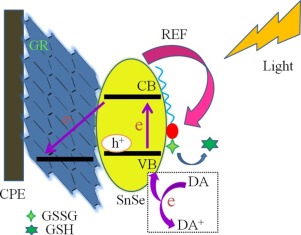Sensors and Actuators B: Chemical ( IF 8.0 ) Pub Date : 2018-01-04 , DOI: 10.1016/j.snb.2018.01.074 Shanshan Wang , Xu Hun , Xiliang Luo

|
The continued expansion of the fields of photoelectrochemical (PEC) aptasensor has guided the development of photoactive materials that can generate electron-photo pairs to emerge photocurrent. However, only such an improvement has an insatiable appetite for the application of molecular level for PEC aptasensor due to the limited quantity of the bioprobes immobilized on the working electrode. Here, we successfully synthetized SnSe/graphene (SnSe/GR) nanohybrids as a photoactive material with a strong photocurrent signal. The constructed bioprobe, DNA/gold nanoparticles/glutathione disulfide (DNA/AuNPs/GSSG), decreased photocurrent effectively. GSSG, an electron acceptor, was designed as a quencher in the bioprobe to overcome a part of shortcomings of DNA/AuNPs in a way. This was owing to the resonance energy transfer (RET) between AuNPs and SnSe/GR, and GSSG to accept photoelectrons, so that the photocurrent response was obviously decreased comparing to the PEC response of SnSe/GR/CPE. Based on this, probe/SnSe/GR/CPE was built as a signal-on PEC aptasensor to detect endocrine-disrupting chemicals using bisphenol A as model. This signal-on PEC aptasensor showed a linear response in the range of 0.01–7 μM and a limit of detection of 3 nM for bisphenol A. And this method presented a promising prospect for sensitive and accurate analysis of other biological molecules between aptamers and corresponding targets at low levels.
中文翻译:

基于SnSe / GR和AuNPs与GSSG之间共振能量转移的光电化学破坏内分泌的化学适体,用于信号放大
光电化学(PEC)适体传感器领域的不断扩展指导了光敏材料的发展,该材料可以产生电子-光对以产生光电流。但是,由于固定在工作电极上的生物探针数量有限,因此只有这样的改进才能满足PEC适体传感器分子水平的应用需求。在这里,我们成功地合成了SnSe /石墨烯(SnSe / GR)纳米杂化物作为具有强光电流信号的光敏材料。构建的生物探针DNA /金纳米颗粒/谷胱甘肽二硫化物(DNA / AuNPs / GSSG)有效降低了光电流。GSSG是一种电子受体,被设计用作生物探针中的淬灭剂,以某种方式克服DNA / AuNPs的部分缺点。这是由于AuNPs与SnSe / GR之间的共振能量转移(RET),以及GSSG接受光电子,因此与SnSe / GR / CPE的PEC响应相比,光电流响应明显降低。在此基础上,构建探针/ SnSe / GR / CPE作为信号上的PEC适体传感器,以双酚A为模型检测干扰内分泌的化学物质。这种带信号的PEC适体传感器在0.01–7μM范围内表现出线性响应,双酚A的检出限为3 nM。该方法为灵敏,准确地分析适体与相应分子之间的其他生物分子提供了广阔的前景。低水平的目标。探针/ SnSe / GR / CPE被构建为信号上PEC适体传感器,以双酚A为模型来检测干扰内分泌的化学物质。这种带信号的PEC适体传感器在0.01–7μM范围内表现出线性响应,双酚A的检出限为3 nM。该方法为灵敏,准确地分析适体与相应分子之间的其他生物分子提供了广阔的前景。低水平的目标。探针/ SnSe / GR / CPE被构建为信号上PEC适体传感器,以双酚A为模型检测干扰内分泌的化学物质。这种带信号的PEC适体传感器在0.01–7μM范围内表现出线性响应,双酚A的检出限为3 nM。该方法为灵敏,准确地分析适体与相应分子之间的其他生物分子提供了广阔的前景。低水平的目标。











































 京公网安备 11010802027423号
京公网安备 11010802027423号